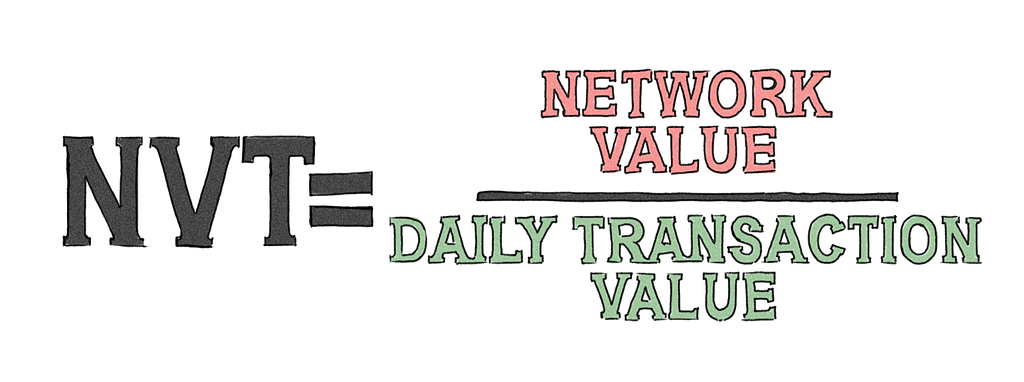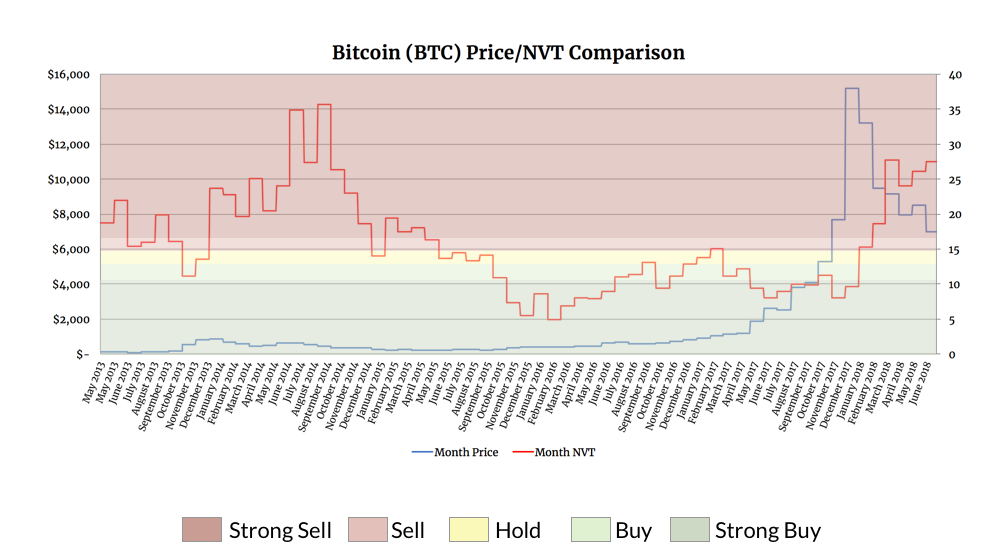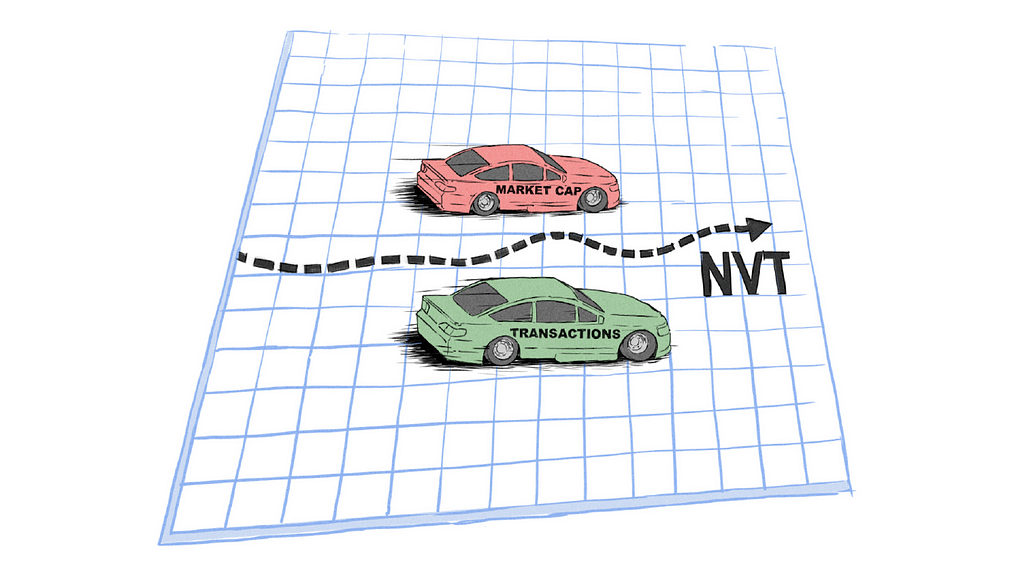Latest news about Bitcoin and all cryptocurrencies. Your daily crypto news habit.
Have you ever wondered how to actually measure the true value of Bitcoin? Wouldn’t it be useful information to know that Ethereum is currently under-priced and potentially about to skyrocket in value? Perhaps you are looking to sell a handful of Ripple for Bitcoin, but don’t know if it’s the right time yet. In traditional finance, there are established tools to provide insight into making these decisions in traditional stocks, but those same tools don’t typically relate or apply to crypto. However, algorithmic index trading platforms like Samsa.ai are working to implement this valuable ratio into their index funds to make cryptocurrency traders better returns.
How NVT Works as a Valuation Metric
The Network Value to Transactions Ratio, or “NVT”, provides us with insight into how to assign fair value to coins in an industry where doing so can be tediously difficult, if not impossible. It is one of the key measures that analysts and proactive investors are currently using to gauge and appropriately value cryptoassets. Willy Woo, the creator of this insightful metric, has some fascinating insight into the importance of NVT as a primary ratio to follow in cryptocurrency on his site. He goes on to say:
“When Bitcoin’s NVT is high, it indicates that its network valuation is outstripping the value being transmitted on its payment network. This can happen when the network is high growth and investors are valuing it as a high return investment, or alternatively when the price is in an unsustainable bubble.”
NVT is a way to equivalently compare unknown intrinsic values of cryptocurrencies. When we look at how the NVT line relates to its normal range, we can gauge when Bitcoin is becoming overvalued or undervalued. In an interview a year ago, Woo said:
“We didn’t know how to value internet stocks in the 1990’s. P/E ratios were through the roof and people didn’t understand zero marginal cost of companies. …In Bitcoin, we know the transaction throughput, but we don’t know its earnings as it is not a company. It’s the closest proxy we have to it. That’s all it is really. If Bitcoin was a payment company, let’s measure how much throughput it has, to its valuation.”
Most successful traditional stock investors are familiar with the Price-Earnings (P/E) ratio. Put simply, by dividing a company’s current market price by its current earnings per share, the P/E ratio allows investors to gauge a stock’s growth potential. More importantly, it can provide insight into whether a company is undervalued, fairly valued, or overvalued based on its current market position.
How to Calculate NVT
Let’s take a look at this formula in greater detail:
This calculation is straightforward, only needs two variables to solve, and provides us with a telling number if we compare it to an individual coin’s own historic values or to other coin’s values over the same timeframe.
Let’s do a quick sample with Bitcoin, using June 10, 2018 as an example. Here are some metrics from Coinmetrics:
- 6/10/18 Market Cap (Network Value): $128,128,000,000
- 6/10/18 Transaction Volume (USD): $7,172,614,294
- 6/10/18 NVT (Market Cap / Transaction Volume): 17.86
As we can see, dividing Bitcoin’s market cap value by its transaction volume for just this 24-hour period, we get an NVT value of 17.86. Wonderful.
Now, let’s give that number some actual meaning. How does an NVT of 17.86 on one particular day compare to the all-time average historical NVT ratio of Bitcoin? Note — this data begins with its first full month of data in May 2013:
- Median Historical Market Cap (Network Value): $7,329,110,000
- Median Historical Transaction Volume (USD): $666,703,284
- Median NVT (Market Cap / Transaction Volume): 13.70*
* Note that for the most precise statistical evaluation, the average NVT is being calculated as the median value among roughly six years worth of Bitcoin data.
We can see that the overall median NVT for all individual Bitcoin daily data from CoinMetrics is roughly 13.70, which makes the 17.86 NVT value we found in our calculation for June 10, 2018 a moderate 30.4% above its average historical rate.
How to Interpret NVT
If we are looking to buy, we would want to see a higher transaction volume compared to market cap, as this would indicate there is a convincingly significant amount of utility (transactions) currently being used in the world.
With our Bitcoin example, we can see that June 10th did not have the transaction volume we would want to see with the current market cap levels. Therefore, this value would be an indicator that the price of $7,499.55 was overvalued. Remember, this was only one specific day, and these numbers can vary drastically on a day to day basis compared to daily price shifts.
It is worth mentioning that, here at Samsa, we are getting our statistics from CoinMetrics, which has a disclaimer on their website’s FAQ:
“…other estimates of NVT are done only for Bitcoin, and use blockchain.info’s estimate volume, other than very straightforward exclusions. Thus Blockchain.info has an estimate of USD volume transmitted on chain that’s 5–6 times lower than ours, resulting in a higher NVT.”
It is worth taking note of this delta, as Woo’s website will often have Bitcoin NVT values averaging triple digits, while Samsa’s calculations are significantly lower. Either data source is acceptable, and proportionally the lines over time in either analysis should ebb and flow similarly.
Let’s look at a visualization of our monthly NVT data from Coinmetrics and see how Bitcoin’s price has correlated along with it:
When creating this model for Bitcoin, there were plenty of things I had to factor in during the process of putting it together, as well as plenty of things I noticed after it was completed:
- The respective buy, hold, and sell zones were formulated based on history combined with some math. Keep in mind these color groupings are only applicable to the orange NVT line corresponding to the right y-axis on the chart. The zones are all based around the median historic NVT value for Bitcoin, which as we learned above, currently sits at about 13.7. I knew that I would want to symmetrically make the hold zone slightly above and slightly below this number by the same percentage basis on both sides. I was also able to notice trends via this time scale indicating almost no price movement whenever the orange line fell within 7.5% above or below this median value of 13.7. This gave me a range of about 15% for the yellow hold zone, and the same 15% window was used to create the other zones.
- I originally considered magnifying plot points to scale daily, but there are too many outlier NVT spikes that don’t correlate with price. Instead, I decided to use the mean average for every month as plot points, and we can see some VERY significant and statistically meaningful movement of Bitcoin’s monthly price (in blue) over time in comparison to its monthly Network to Value Transaction ratio (in orange).
- From an overall historic perspective, we can see that our orange NVT line is splitting a bit under half its time in either the “Buy” or “Strong Buy” zones, a bit under half the time in the “Sell” or “Strong Sell” zones, and the remainder of time in the hold zone. But how could there be an equal number of buy and sell signals from the all-time NVT chart if Bitcoin has gone up 60 times its value since May of 2013? Well, this is the beauty of Bitcoin and cryptocurrency as a market still in its infancy stage. Historically, when Bitcoin’s NVT value is in the buy zones, there is historically much more upside to price movement than there is downside when in the sell zones. For skeptics of NVT, an argument could be made that this is a flaw of the formula overall and shows NVT as unreliable and unpredictable when it is well above its median average. Admittedly, there is much less consistent correlation compared to the large price leaps that strongly correlate whenever the chart is in a buy zone.
- We can see that when Bitcoin’s price exploded in mid-late 2013, this correlated with its NVT dipping into the green buy zones for the first time. We can see this confirmed again on a larger scale when NVT again went into the green beginning in September of 2015 and lasting all the way until December of 2017. This 28 month stretch of Bitcoin’s NVT range providing buy signals saw its price shoot from below $250 to above $19,000.
There is no perfect solution to accurately value cryptoassets that have no real company representation, balance sheets, or quarterly earnings reports. However, there are a couple reasons for using NVT as a metric:
- NVT can be a good indicator of relative value compared to other coins and individual coin historical price based on their averages over time.
- NVT can be calculated for most popularly traded coins, as those coins have their own historical market caps and number of transactions recorded.
Don’t Forget — It Is Still Crypto
Of course, there are several pieces of news over the years that have historically contributed to the monthly rises and falls of Bitcoin’s price. And no matter how much we here at Samsa love the Network Value to Transactions ratio, it is not the sole metric of value. There will be occasions where NVT will completely fail as a reliable indicator for a coin’s price, particularly on a short-term timeframe.
Because cryptocurrency’s value is so heavily influenced by human speculation, it can be extremely difficult to rely on a mathematical ratio to predict a price line that is essentially controlled exclusively by its investors. Anyone who depends solely on the NVT ratio, MACD and RSI indicators, Bollinger Band signals, or any other individual metric as a sole indicator for price direction without understanding the risk involved or weighing other fundamental factors, has a high likelihood of eventually failing as a trader.
We view NVT as a very useful supplementary research aid when investing. The metric is not an end-all, be-all key to easily buy low and sell high for easy profits, but we’ve seen evidence that the NVT line has preceded many major market price shifts in both directions. And when we see evidence of a ratio that, more often than not, has a strong long-term correlation to price and often foreshadows the direction of future price (on a long-term basis), it is a fundamental metric worth not only understanding, but paying serious attention to.
I write in depth cryptocurrency analysis at Samsa, the passive investing tool for crypto. See what we’re doing at Samsa.ai and see our other analysis at our magazine. If you love what you see, give this article 50 claps! If you hate it, show your displeasure with 49.
This article and related content is for informational purposes only. It should not be considered investment advice, and you should consult a financial advisor and do your own research and due diligence prior to making any investments. Where securities or commodities are referenced, it is only for illustrative purposes only, and does not imply any position on securities or commodities classification. To the extent that Samsa services are offered or discussed, those services are available only for Samsa whitelisted assets only.
The NVT Ratio was originally published in Hacker Noon on Medium, where people are continuing the conversation by highlighting and responding to this story.
Disclaimer
The views and opinions expressed in this article are solely those of the authors and do not reflect the views of Bitcoin Insider. Every investment and trading move involves risk - this is especially true for cryptocurrencies given their volatility. We strongly advise our readers to conduct their own research when making a decision.



